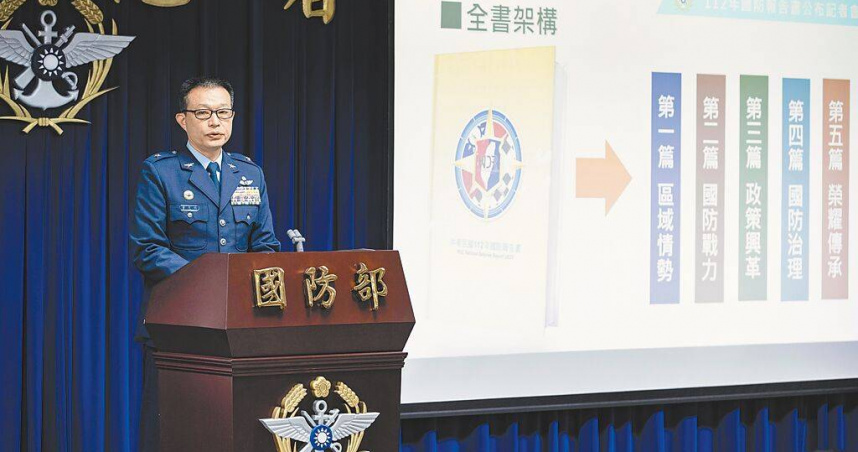The Ministry of National Defense pointed out in the “2023 of the Chinese Communist Party’s (CCP) Military Power Report” that the CCP incorporated the principle of “one country, two systems” into the CCP’s constitution at the CCP’s 20th National Congress, the direction of its Taiwan policy was clearer, and Xi Jinping proposed to “unswervingly promote the process of reunification of the motherland”, which obviously may promote the process of resolving the “Taiwan issue” during his third term.
The Ministry of National Defense (MND) today sent the “National Defense Budget for the 2024 of the Republic of China,” the “Report on the Military Strength of CCP for the 2023,” and the “Report on the Five-Year Military Strength Consolidation and Administration Plan of the Ministry of National Defense” to the Legislative Yuan.
The “Report on the Military Strength of CCP for the 2023” said, since the start of the Russian-Ukrainian war last year, international geopolitics has turned into a confrontation between the two major groups of democratic countries of the United States Alliance and pro-China totalitarian countries, each of which has won over like-minded countries, deepened military strategic partnership, and jointly affected Taiwan policy.
The Ministry of National Defense also pointed out that observing the personnel layout of the 20th Central Military Commission, the generals of the Central Military Commission have actual combat experience, scientific and technological expertise, and familiarity with Taiwan Strait affairs.
For example, Zhang Youxia (張又俠), vice chairman of the Central Military Commission, who participated in battles such as the 1979 Sino-Vietnamese War, remained in office;
He Weidong(何衛東), vice chairman of the Central Military Commission, was once the commander of the Eastern Theater and was familiar with Taiwan’s combat readiness affairs.
Defense Minister Li Shangfu (李尚福) is an aerospace expert of the Communist Party of China, and has vigorously promoted the development of weaponry and equipment in science and technology, informatization and actual combat;
Joint Chief of Staff Liu Zhenli (劉振立) participated in the campaign against Vietnam.
The Ministry of National Defense stressed that it is obvious that the PLA has strengthened its combat readiness against Taiwan and improved its anti-access/area denial (A2/AD) capabilities as the key direction of the troops’ combat training.
At the strategic level of each service, the Ministry of Defense pointed out that the CCP Army has improved the troop establishment of the “combine arms brigade” unit (similar to the Taiwan joint arms battalion) to build an efficient, overall and versatile army; The naval component ensures that by 2035, in the waters between the first and second island chains, strategic defense depth and combat capability against strong enemies will be established; The air force part will ensure that a strategic air force with both offensive and defensive capabilities will be built by 2035, and at the same time have the air mobility, supply and strategic depth strike capabilities required for operations in the second island chain.
In the part of the Rocket Force, it will establish a precision strike capability against the enemy in the first island chain in 2027, and build a nuclear-space integrated information-based strategic nuclear energy in 2050; The strategic support force will become the key force for the communist army to win the information war; The People’s Armed Police Force will carry out defensive operations in wartime.
As for the CCP’s assessment of the threat to Taiwan and the timing of the invasion of Taiwan, the defense department pointed out that the PLA continues to engage in military operations of different threat intensities in the sea and air space around Taiwan, and uses joint combat readiness patrols and long-distance sea voyages to demonstrate the ability to resist foreign military intervention in Taiwan Strait affairs, increase the difficulty of external military intervention in wartime, and respond to possible international countermeasures in advance.
國防部今天向立法院提交了「民國113年度 (2024) 國防預算書」、「112年 (2023) 中共軍力報告書」以及「國防部五年兵力整建及施政計畫報告」。
國防部在中共軍力報告中指出,自去年俄烏戰爭爆發以來,國際地緣政治已轉變為美國及其盟友的民主國家與親中極權國家之間的兩大勢力對抗,雙方都在積極拉攏理念相近的國家,並加深軍事戰略夥伴關係,這也影響了對台政策的走向。
報告分析,中共在第20次全國代表大會上,將「一個國家,兩種制度」的方針修訂納入共產黨章程,顯示其對台政策的方向愈加明確。此外,中國國家主席習近平在今年的全國人民代表大會上提到「堅定不移推進祖國統一進程」,這表明中共可能在習近平的第三任期內,推動解決「台灣問題」。
國防部還指出,從第20屆中央軍事委員會的人事安排來看,軍委會的將領具備「實戰經驗」、「科技專長」及「熟悉台海事務」等背景。
例如,軍委副主席張又俠曾參加1979年的中越戰爭,破格留任;軍委副主席何衛東曾任東部戰區司令,對台戰備事務非常熟悉;國防部長李尚福是中共的航天專家,積極推動武器裝備的科技化、信息化及實戰化發展;聯合參謀長劉振立也曾參加對越戰役。國防部強調,這些人事安排顯示共軍正在加強對台作戰的準備,提升反介入/區域拒止(A2/AD)能力,作為部隊訓練的重點方向。
在各軍種的戰略層面上,國防部指出,中共陸軍正在完善其「合成旅」部隊編制,這類部隊類似於台灣的聯合兵種營,旨在建設一支高效、全域及多功能的陸軍。至於海軍,目標是在2035年前,在第一島鏈至第二島鏈之間的海域建立戰略防禦深度及抵禦強敵的能力。空軍方面,則計劃在2035年之前建成具備攻防能力的戰略空軍,並具備對第二島鏈作戰所需的空中機動、補給及戰略打擊能力。
在火箭軍方面,計劃到2027年建立在第一島鏈內對敵的精準打擊能力,並在2050年實現核天一體的信息化戰略核能量。戰略支援部隊將成為共軍在信息化戰爭中取勝的關鍵力量,而武警部隊則在戰時負責防衛作戰。
關於中共對台灣的威脅評估及可能的攻台時機,國防部指出,共軍持續在台灣周邊海空域進行各種強度的軍事行動,並透過聯合戰備警巡和遠海長航等方式,展示其拒止外軍介入台海事務的能力,並提高外部軍力在戰時介入的難度。此外,為了應對國際可能的反制措施,國防部研判共軍將繼續以低、中、高強度的「軍事活動」來對台保持軍事威懾。



